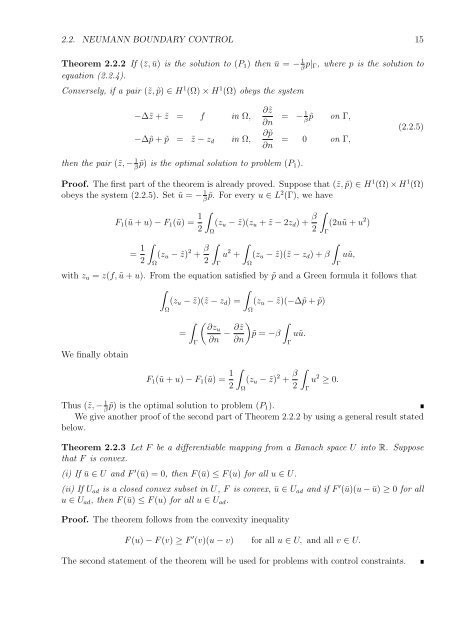Optimal Control of Partial Differential Equations
Optimal Control of Partial Differential Equations
Optimal Control of Partial Differential Equations
You also want an ePaper? Increase the reach of your titles
YUMPU automatically turns print PDFs into web optimized ePapers that Google loves.
2.2. NEUMANN BOUNDARY CONTROL 15<br />
Theorem 2.2.2 If (¯z, ū) is the solution to (P1) then ū = − 1<br />
β p|Γ, where p is the solution to<br />
equation (2.2.4).<br />
Conversely, if a pair (˜z, ˜p) ∈ H 1 (Ω) × H 1 (Ω) obeys the system<br />
−∆˜z + ˜z = f in Ω,<br />
−∆˜p + ˜p = ˜z − zd in Ω,<br />
∂˜z<br />
∂n<br />
∂ ˜p<br />
∂n<br />
then the pair (˜z, − 1 ˜p) is the optimal solution to problem (P1).<br />
β<br />
1 = − ˜p on Γ,<br />
β<br />
= 0 on Γ,<br />
(2.2.5)<br />
Pro<strong>of</strong>. The first part <strong>of</strong> the theorem is already proved. Suppose that (˜z, ˜p) ∈ H 1 (Ω) × H 1 (Ω)<br />
obeys the system (2.2.5). Set ũ = − 1<br />
β ˜p. For every u ∈ L2 (Γ), we have<br />
F1(ũ + u) − F1(ũ) = 1<br />
2<br />
<br />
= 1<br />
<br />
(zu − ˜z)<br />
2 Ω<br />
2 + β<br />
2<br />
Γ<br />
(zu − ˜z)(zu + ˜z − 2zd) +<br />
Ω<br />
β<br />
2<br />
<br />
Γ<br />
u 2 <br />
<br />
+ (zu − ˜z)(˜z − zd) + β<br />
Ω<br />
<br />
Γ<br />
(2uũ + u 2 )<br />
with zu = z(f, ũ + u). From the equation satisfied by ˜p and a Green formula it follows that<br />
<br />
<br />
(zu − ˜z)(˜z − zd) = (zu − ˜z)(−∆˜p + ˜p)<br />
Ω<br />
Ω<br />
<br />
=<br />
<br />
∂zu ∂˜z<br />
− ˜p = −β<br />
∂n ∂n<br />
uũ.<br />
We finally obtain<br />
F1(ũ + u) − F1(ũ) = 1<br />
<br />
(zu − ˜z)<br />
2 Ω<br />
2 + β<br />
<br />
u<br />
2 Γ<br />
2 ≥ 0.<br />
Thus (˜z, − 1 ˜p) is the optimal solution to problem (P1).<br />
β<br />
We give another pro<strong>of</strong> <strong>of</strong> the second part <strong>of</strong> Theorem 2.2.2 by using a general result stated<br />
below.<br />
Theorem 2.2.3 Let F be a differentiable mapping from a Banach space U into R. Suppose<br />
that F is convex.<br />
(i) If ū ∈ U and F ′ (ū) = 0, then F (ū) ≤ F (u) for all u ∈ U.<br />
(ii) If Uad is a closed convex subset in U, F is convex, ū ∈ Uad and if F ′ (ū)(u − ū) ≥ 0 for all<br />
u ∈ Uad, then F (ū) ≤ F (u) for all u ∈ Uad.<br />
Pro<strong>of</strong>. The theorem follows from the convexity inequality<br />
Γ<br />
Γ<br />
uũ,<br />
F (u) − F (v) ≥ F ′ (v)(u − v) for all u ∈ U, and all v ∈ U.<br />
The second statement <strong>of</strong> the theorem will be used for problems with control constraints.

















